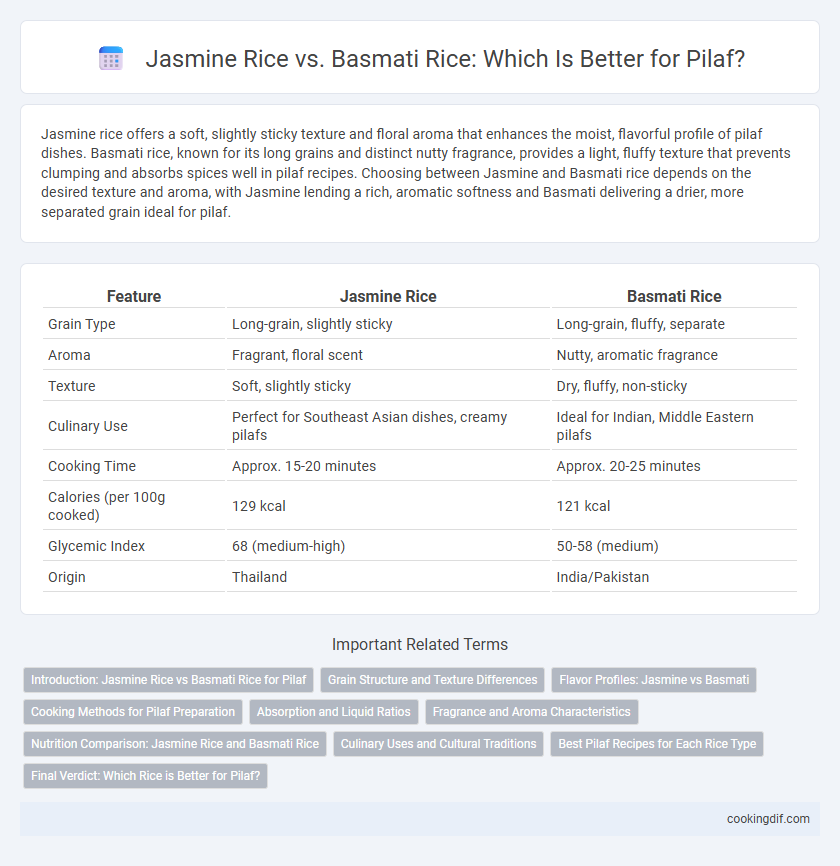Jasmine rice offers a soft, slightly sticky texture and floral aroma that enhances the moist, flavorful profile of pilaf dishes. Basmati rice, known for its long grains and distinct nutty fragrance, provides a light, fluffy texture that prevents clumping and absorbs spices well in pilaf recipes. Choosing between Jasmine and Basmati rice depends on the desired texture and aroma, with Jasmine lending a rich, aromatic softness and Basmati delivering a drier, more separated grain ideal for pilaf.
Table of Comparison
| Feature | Jasmine Rice | Basmati Rice |
|---|---|---|
| Grain Type | Long-grain, slightly sticky | Long-grain, fluffy, separate |
| Aroma | Fragrant, floral scent | Nutty, aromatic fragrance |
| Texture | Soft, slightly sticky | Dry, fluffy, non-sticky |
| Culinary Use | Perfect for Southeast Asian dishes, creamy pilafs | Ideal for Indian, Middle Eastern pilafs |
| Cooking Time | Approx. 15-20 minutes | Approx. 20-25 minutes |
| Calories (per 100g cooked) | 129 kcal | 121 kcal |
| Glycemic Index | 68 (medium-high) | 50-58 (medium) |
| Origin | Thailand | India/Pakistan |
Introduction: Jasmine Rice vs Basmati Rice for Pilaf
Jasmine rice offers a soft, slightly sticky texture with a floral aroma that enhances the richness of pilaf dishes, while Basmati rice provides distinct, long grains and a nutty fragrance ideal for fluffy, separated pilaf. The moisture content of jasmine rice creates a creamier consistency, whereas basmati rice's lower starch content results in a drier, fluffier pilaf. Choosing between jasmine and basmati rice depends on the desired pilaf texture and flavor profile in recipes.
Grain Structure and Texture Differences
Jasmine rice has a soft, slightly sticky grain structure ideal for absorbing flavors in pilaf, creating a moist and tender texture. Basmati rice features long, slender grains with a firm, separate texture that remains fluffy and non-sticky when cooked. The distinct grain structures influence the final pilaf texture, with jasmine providing creaminess and basmati delivering a light, airy consistency.
Flavor Profiles: Jasmine vs Basmati
Jasmine rice offers a delicate, floral aroma with a slightly sticky texture, enhancing the richness of pilaf by absorbing spices and broth flavors seamlessly. Basmati rice provides a nutty, aromatic profile with individual grains that remain fluffy and separate, adding a fragrant and textured dimension ideal for pilaf dishes. Choosing between Jasmine and Basmati rice impacts the pilaf's overall taste experience, balancing between floral-sweet notes and nutty-aromatic flavors.
Cooking Methods for Pilaf Preparation
Jasmine rice requires a slightly shorter cooking time and benefits from a gentle simmer to retain its fragrant aroma and soft texture, while basmati rice demands soaking before cooking to elongate the grains and achieve a fluffy, non-sticky consistency ideal for pilaf. Pilaf preparation with jasmine rice often involves sauteing the rice in oil or butter before adding broth, enhancing its natural sweetness and moisture absorption. Basmati pilaf typically involves a precise water-to-rice ratio and controlled steaming to prevent clumping and preserve the distinct, separate grains essential for authentic pilaf dishes.
Absorption and Liquid Ratios
Jasmine rice absorbs liquid quickly and typically requires a 1:1.5 rice-to-water ratio for pilaf, resulting in a moist and slightly sticky texture. Basmati rice, known for its long grains and fluffiness, needs a higher liquid ratio of about 1:1.75 to achieve the ideal absorption without becoming mushy. Understanding these differences in absorption and liquid ratios is crucial for perfecting pilaf with each rice variety.
Fragrance and Aroma Characteristics
Jasmine rice offers a naturally sweet, floral aroma with a delicate fragrance that enhances the sensory experience of pilaf dishes. Basmati rice is characterized by a nutty, spicy scent with a distinctive aged aroma that adds depth to pilaf recipes. The choice between Jasmine and Basmati rice for pilaf largely depends on whether a sweeter or more aromatic, complex fragrance is preferred.
Nutrition Comparison: Jasmine Rice and Basmati Rice
Jasmine rice contains about 130 calories and 3 grams of protein per 1/4 cup dry serving, offering a higher glycemic index suitable for quick energy but less fiber compared to basmati rice. Basmati rice provides approximately 120 calories, 3 grams of protein, and 1 gram of dietary fiber per 1/4 cup dry, featuring a lower glycemic index that supports better blood sugar control and sustained energy release. Both varieties contain essential minerals like iron and magnesium, but basmati rice generally offers a slightly higher nutrient density beneficial for balanced pilaf recipes.
Culinary Uses and Cultural Traditions
Jasmine rice, with its fragrant aroma and slightly sticky texture, is ideal for Southeast Asian pilaf dishes, complementing flavors in Thai and Vietnamese cuisine. Basmati rice, renowned for its long grains and fluffy, non-sticky texture, is preferred in Indian and Middle Eastern pilafs, where it absorbs spices without clumping. Both varieties hold significant cultural importance, with jasmine rice integral to Thai celebrations and basmati rice traditionally favored in Indian festive meals.
Best Pilaf Recipes for Each Rice Type
Jasmine rice, known for its soft texture and floral aroma, excels in pilaf recipes that highlight Southeast Asian flavors, such as coconut milk and lemongrass-infused dishes. Basmati rice, prized for its long grains and nutty fragrance, is ideal for pilafs featuring Indian and Middle Eastern spices like cumin, cardamom, and saffron, which enhance its distinct texture and taste. Each rice variety requires tailored cooking techniques to achieve the perfect pilaf consistency--fluffy yet separate grains for Basmati and slightly sticky, tender grains for Jasmine.
Final Verdict: Which Rice is Better for Pilaf?
Jasmine rice offers a soft, slightly sticky texture with a floral aroma, making it ideal for creamy pilafs where moisture retention is desired. Basmati rice, known for its long grains and distinct nutty flavor, provides a fluffy, separate grain structure perfect for pilafs that emphasize individual texture. For traditional pilaf dishes prioritizing separate, fluffy grains, basmati rice is the superior choice, while jasmine excels in recipes favoring a moist, fragrant consistency.
Jasmine rice vs Basmati rice for pilaf Infographic

 cookingdif.com
cookingdif.com